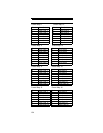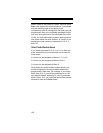
138
want to scan by visiting the forums section of
http://www.radioreference.com/forums.
• Before you start to program your scanner, decide
how you want to organize the frequencies you
want to scan. For example, some areas are best
organized by geographic location (east, north,
south, west, central, etc), while others are best
organized by agency (police, sheriff, ambulance,
fire, etc.). You might even find it easier to organize
a mixture of frequencies (north, southeast, and
west for police but fire all in one group for exam-
ple).
2. Organize the system information using these sys-
tem worksheets included in this appendix.
• Use “” on Page 143 to organize info about conven-
tional frequencies.
• Use “Motorola system Worksheet" on Page 144 to
organize information about Motorola frequencies.
• Use "LTR/EDACS System Worksheet" on Page
146 to organize information about LTR and
EDACS frequencies.
3. Follow the instructions in “Filling Out The Conven-
tional System Worksheet” on Page 139, “Filling
Out The Motorola Worksheet” on Page 139, and
“Filling Out the LTR and EDACS Worksheet” on
Page 141 to program your scanner.
Tips:
• Before you start, make as many copies of the
worksheets as you think you'll need. You can also
go to the download section of
http://www.uniden.com/productsupport.cfm and
download the worksheets there.
• All worksheet instructions assume that you have
completed the critical Step 1 (collecting the system
information). Don't skip this step.
• Use a pencil to fill out the worksheets. This lets
you change information if necessary.


















